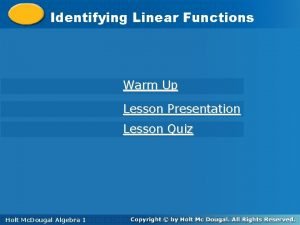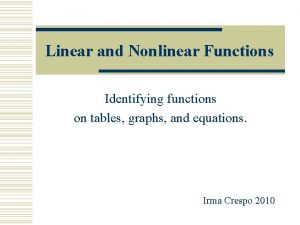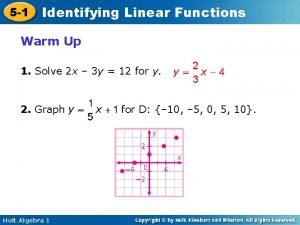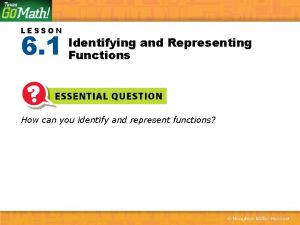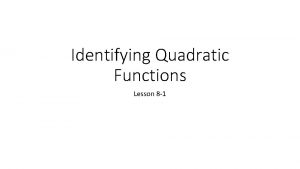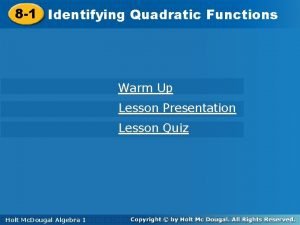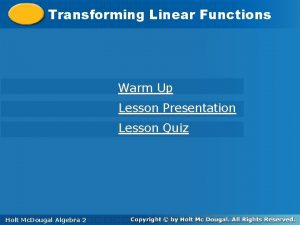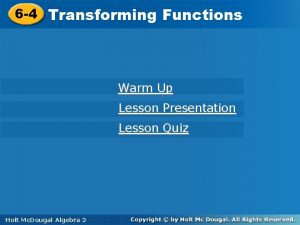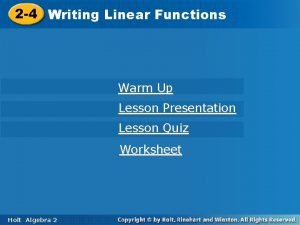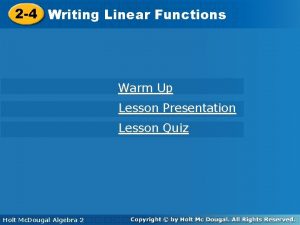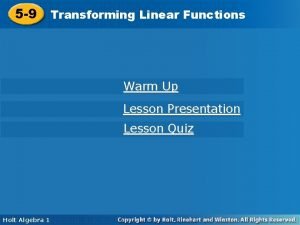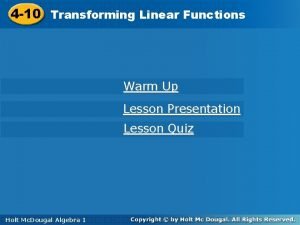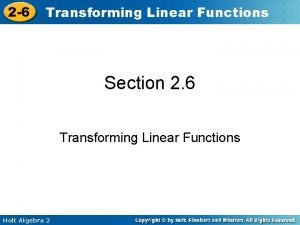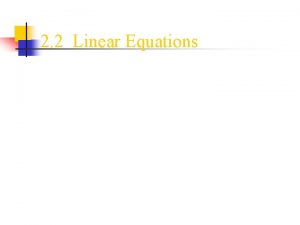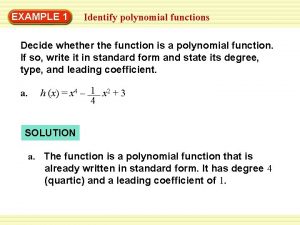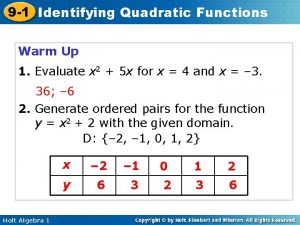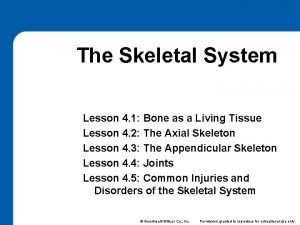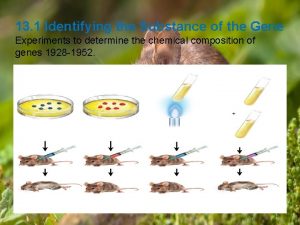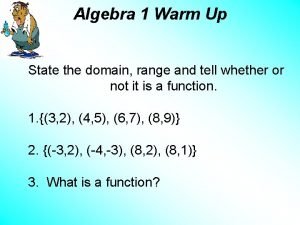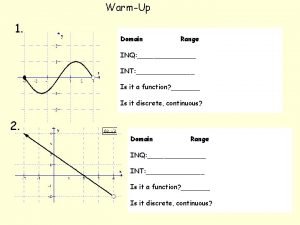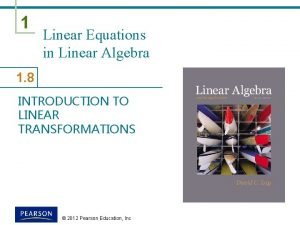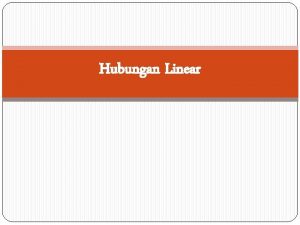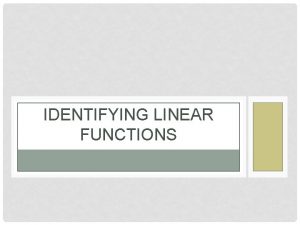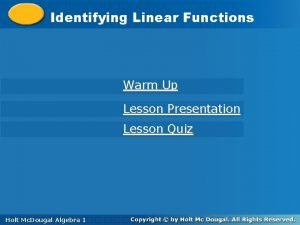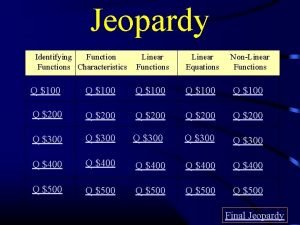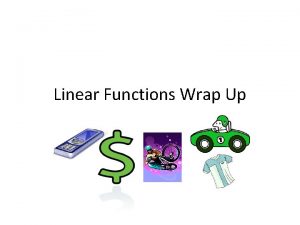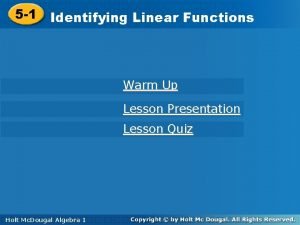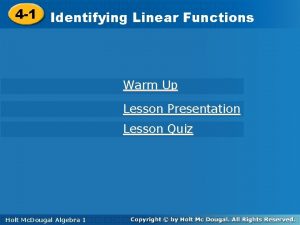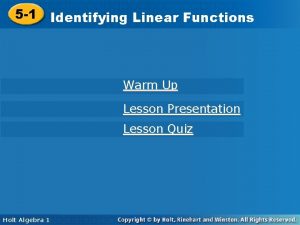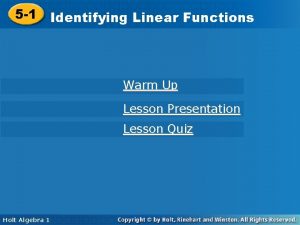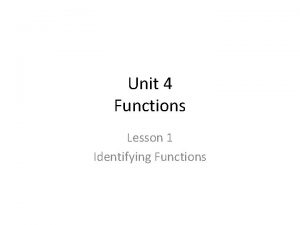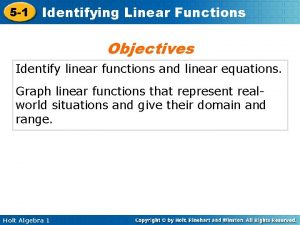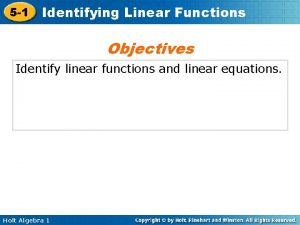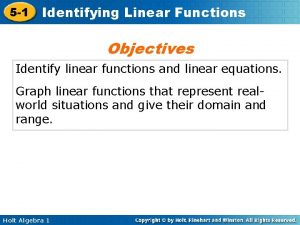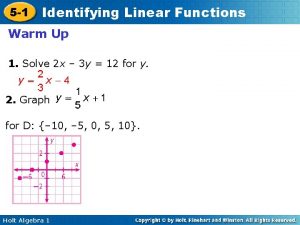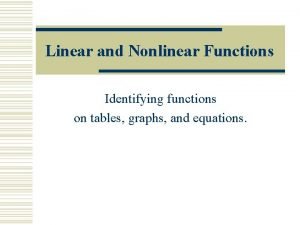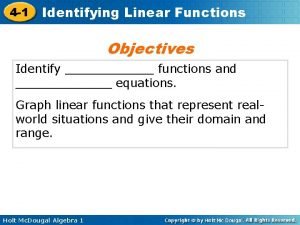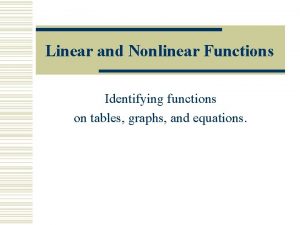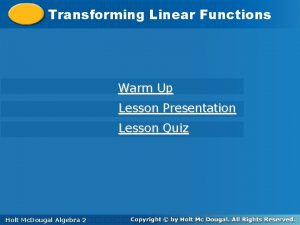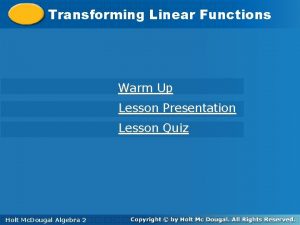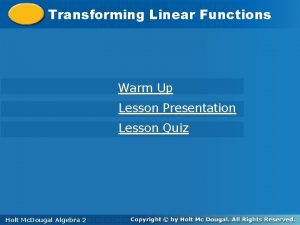5 1 Identifying Linear Functions Warm Up Lesson







































- Slides: 39

5 -1 Identifying. Linear. Functions Warm Up Lesson Presentation Lesson Quiz Holt Algebra 1

5 -1 Identifying Linear Functions Warm Up 1. Solve 2 x – 3 y = 12 for y. 2. Graph Holt Algebra 1 for D: {– 10, – 5, 0, 5, 10}.

5 -1 Identifying Linear Functions Objectives Identify linear functions and linear equations. Graph linear functions that represent realworld situations and give their domain and range. Holt Algebra 1

5 -1 Identifying Linear Functions Vocabulary linear function linear equation Holt Algebra 1

5 -1 Identifying Linear Functions The graph represents a function because each domain value (x-value) is paired with exactly one range value (y-value). Notice that the graph is a straight line. A function whose graph forms a straight line is called a linear function. Holt Algebra 1

5 -1 Identifying Linear Functions Example 1 A: Identifying a Linear Function by Its Graph Identify whether the graph represents a function. Explain. If the graph does represent a function, is the function linear? Each domain value is paired with exactly one range value. The graph forms a linear function Holt Algebra 1

5 -1 Identifying Linear Functions Example 1 B: Identifying a Linear Function by Its Graph Identify whether the graph represents a function. Explain. If the graph does represent a function, is the function linear? Each domain value is paired with exactly one range value. The graph is not a linear function Holt Algebra 1

5 -1 Identifying Linear Functions Example 1 C: Identifying a Linear Function by Its Graph Identify whether the graph represents a function. Explain. If the graph does represent a function, is the function linear? The only domain value, – 2, is paired with many different range values. not a function Holt Algebra 1

5 -1 Identifying Linear Functions Check It Out! Example 1 a Identify whether the graph represents a function. Explain. If the graph does represent a function, is the function linear? Each domain value is paired with exactly one range value. The graph forms a linear function Holt Algebra 1

5 -1 Identifying Linear Functions Check It Out! Example 1 b Identify whether the graph represents a function. Explain. If the graph does represent a function, is the function linear? Each domain value is paired with exactly one range value. The graph forms a linear function Holt Algebra 1

5 -1 Identifying Linear Functions Check It Out! Example 1 c Identify whether the graph represents a function. Explain. If the graph does represent a function, is the function linear? Each domain value is not paired with exactly one range value. not a function Holt Algebra 1

5 -1 Identifying Linear Functions You can sometimes identify a linear function by looking a table or a list of ordered pairs. In a linear function, a constant change in x corresponds to a constant change in y. Holt Algebra 1

5 -1 Identifying Linear Functions The points from this table lie on a line. In this table, a constant change of +1 in x corresponds to constant change of – 3 in y. These points satisfy a linear function. Holt Algebra 1

5 -1 Identifying Linear Functions The points from this table do not lie on a line. In this table, a constant change of +1 in x does not correspond to a constant change in y. These points do not satisfy a linear function. Holt Algebra 1

5 -1 Identifying Linear Functions Example 2 A: Identifying a Linear Function by Using Ordered Pairs Tell whether the set of ordered pairs satisfies a linear function. Explain. {(0, – 3), (4, 0), (8, 3), (12, 6), (16, 9)} x +4 +4 Holt Algebra 1 y 0 – 3 4 0 8 3 12 6 16 9 +3 +3 Write the ordered pairs in a table. Look for a pattern. A constant change of +4 in x corresponds to a constant change of +3 in y. These points satisfy a linear function.

5 -1 Identifying Linear Functions Example 2 B: Identifying a Linear Function by Using Ordered Pairs Tell whether the set of ordered pairs satisfies a linear function. Explain. {(– 4, 13), (– 2, 1), (0, – 3), (2, 1), (4, 13)} +2 +2 Holt Algebra 1 x y – 4 13 – 2 1 0 – 3 2 1 4 13 – 12 – 4 +4 +12 Write the ordered pairs in a table. Look for a pattern. A constant change of 2 in x corresponds to different changes in y. These points do not satisfy a linear function.

5 -1 Identifying Linear Functions Check It Out! Example 2 Tell whether the set of ordered pairs {(3, 5), (5, 4), (7, 3), (9, 2), (11, 1)} satisfies a linear function. Explain. +2 +2 Holt Algebra 1 x y 3 5 5 4 7 3 9 2 11 1 – 1 – 1 Write the ordered pairs in a table. Look for a pattern. A constant change of +2 in x corresponds to a constant change of – 1 in y. These points satisfy a linear function.

5 -1 Identifying Linear Functions Another way to determine whether a function is linear is to look at its equation. A function is linear if it is described by a linear equation. A linear equation is any equation that can be written in the standard form shown below. Holt Algebra 1

5 -1 Identifying Linear Functions Notice that when a linear equation is written in standard form • x and y both have exponents of 1. • x and y are not multiplied together. • x and y do not appear in denominators, exponents, or radical signs. Holt Algebra 1

5 -1 Identifying Linear Functions Holt Algebra 1

5 -1 Identifying Linear Functions For any two points, there is exactly one line that contains them both. This means you need only two ordered pairs to graph a line. Holt Algebra 1

5 -1 Identifying Linear Functions Example 3 A: Graphing Linear Functions Tell whether the function is linear. If so, graph the function. x = 2 y + 4 – 2 y x – 2 y = 4 Write the equation in standard form. Try to get both variables on the same side. Subtract 2 y from both sides. The equation is in standard form (A = 1, B = – 2, C = 4). The equation can be written in standard form, so the function is linear. Holt Algebra 1

5 -1 Identifying Linear Functions Example 3 A Continued x = 2 y + 4 To graph, choose three values of y, and use them to generate ordered pairs. (You only need two, but graphing three points is a good check. ) y 0 – 1 – 2 x = 2 y + 4 x = 2(0) + 4 = 4 x = 2(– 1) + 4 = 2 x = 2(– 2) + 4 = 0 Holt Algebra 1 (x, y) (4, 0) (2, – 1) (0, – 2) Plot the points and connect them with a straight line. • • •

5 -1 Identifying Linear Functions Example 3 B: Graphing Linear Functions Tell whether the function is linear. If so, graph the function. xy = 4 This is not linear, because x and y are multiplied. It is not in standard form. Holt Algebra 1

5 -1 Identifying Linear Functions Check It Out! Example 3 a Tell whether the function is linear. If so, graph the function. y = 5 x – 9 – 5 x + y = – 9 Write the equation in standard form. Try to get both variables on the same side. Subtract 5 x from both sides. The equation is in standard form (A = – 5, B = 1, C = – 9). The equation can be written in standard form, so the function is linear. Holt Algebra 1

5 -1 Identifying Linear Functions Check It Out! Example 3 a Continued y = 5 x – 9 To graph, choose three values of x, and use them to generate ordered pairs. (You only need two, but graphing three points is a good check. ) x 0 y = 5 x – 9 y = 5(0) – 9 = – 9 (x, y) (0, – 9) 1 y = 5(1) – 9 = – 4 (1, – 4) 2 y = 5(2) – 9 = 1 (2, 1) Holt Algebra 1 Plot the points and connect them with a straight line. • • •

5 -1 Identifying Linear Functions Check It Out! Example 3 b Tell whether the function is linear. If so, graph the function. y = 12 The equation is in standard form (A = 0, B = 1, C = 12). The equation can be written in standard form, so the function is linear. Holt Algebra 1

5 -1 Identifying Linear Functions Check It Out! Example 3 b Continued y = 12 y Holt Algebra 1

5 -1 Identifying Linear Functions Check It Out! Example 3 c Tell whether the function is linear. If so, graph the function. y = 2 x This is not linear, because x is an exponent. Holt Algebra 1

5 -1 Identifying Linear Functions For linear functions whose graphs are not horizontal, the domain and range are all real numbers. However, in many real-world situations, the domain and range must be restricted. For example, some quantities cannot be negative, such as time. Holt Algebra 1

5 -1 Identifying Linear Functions Sometimes domain and range are restricted even further to a set of points. For example, a quantity such as number of people can only be whole numbers. When this happens, the graph is not actually connected because every point on the line is not a solution. However, you may see these graphs shown connected to indicate that the linear pattern, or trend, continues. Holt Algebra 1

5 -1 Identifying Linear Functions Example 4: Application The relationship between human years and dog years is given by the function y = 7 x, where x is the number of human years. Graph this function and give its domain and range. Choose several values of x and make a table of ordered pairs. x f(x) = 7 x 1 f(1) = 7 2 f(2) = 7(2) = 14 3 f(3) = 7(3) = 21 Holt Algebra 1 The number of human years must be positive, so the domain is {x ≥ 0} and the range is {y ≥ 0}.

5 -1 Identifying Linear Functions Example 4 Continued The relationship between human years and dog years is given by the function y = 7 x, where x is the number of human years. Graph this function and give its domain and range. Graph the ordered pairs. x f(x) = 7 x 1 f(1) = 7 2 f(2) = 7(2) = 14 3 f(3) = 7(3) = 21 Holt Algebra 1 (3, 21) • • (2, 14) • (1, 7)

5 -1 Identifying Linear Functions Check It Out! Example 4 What if…? At a salon, Sue can rent a station for $10. 00 per day plus $3. 00 per manicure. The amount she would pay each day is given by f(x) = 3 x + 10, where x is the number of manicures. Graph this function and give its domain and range. Holt Algebra 1

5 -1 Identifying Linear Functions Check It Out! Example 4 Continued Choose several values of x and make a table of ordered pairs. x f(x) = 3 x + 10 0 f(0) = 3(0) + 10 = 10 1 f(1) = 3(1) + 10 = 13 2 f(2) = 3(2) + 10 = 16 3 f(3) = 3(3) + 10 = 19 4 f(4) = 3(4) + 10 = 22 5 f(5) = 3(5) + 10 = 25 Holt Algebra 1 The number of manicures must be a whole number, so the domain is {0, 1, 2, 3, …}. The range is {10. 00, 13. 00, 16. 00, 19. 00, …}.

5 -1 Identifying Linear Functions Check It Out! Example 4 Continued Graph the ordered pairs. The individual points are solutions in this situation. The line shows that the trend continues. Holt Algebra 1

5 -1 Identifying Linear Functions Lesson Quiz: Part I Tell whether each set of ordered pairs satisfies a linear function. Explain. 1. {(– 3, 10), (– 1, 9), (1, 7), (3, 4), (5, 0)} No; a constant change of +2 in x corresponds to different changes in y. 2. {(3, 4), (5, 7), (7, 10), (9, 13), (11, 16)} Yes; a constant change of +2 in x corresponds to a constant change of +3 in y. Holt Algebra 1

5 -1 Identifying Linear Functions Lesson Quiz: Part II Tell whether each function is linear. If so, graph the function. 3. y = 3 – 2 x no 4. 3 y = 12 yes Holt Algebra 1

5 -1 Identifying Linear Functions Lesson Quiz: Part III 5. The cost of a can of iced-tea mix at Save More Grocery is $4. 75. The function f(x) = 4. 75 x gives the cost of x cans of iced-tea mix. Graph this function and give its domain and range. D: {0, 1, 2, 3, …} R: {0, 4. 75, 9. 50, 14. 25, …} Holt Algebra 1
 Identify linear functions
Identify linear functions Linear and nonlinear tables
Linear and nonlinear tables 5-1 identifying linear functions answer key
5-1 identifying linear functions answer key Identifying and representing functions homework answer key
Identifying and representing functions homework answer key Chapter 4 lesson 8 quadratic functions
Chapter 4 lesson 8 quadratic functions 8-1 identifying quadratic functions
8-1 identifying quadratic functions Adjective
Adjective How to identify clauses
How to identify clauses Identifying and non identifying adjective clauses
Identifying and non identifying adjective clauses Transforming linear functions lesson 6-4
Transforming linear functions lesson 6-4 Lesson 6-4 transforming linear functions
Lesson 6-4 transforming linear functions Lesson 4-10 transforming linear functions answers
Lesson 4-10 transforming linear functions answers Writing functions
Writing functions Lesson 2-4 writing linear equations
Lesson 2-4 writing linear equations Function operations definition
Function operations definition Linear function transformations
Linear function transformations Lesson 6-4 transforming linear functions answer key
Lesson 6-4 transforming linear functions answer key Lesson 6-4 transforming linear functions
Lesson 6-4 transforming linear functions Standard form equation
Standard form equation Identifying polynomial functions
Identifying polynomial functions Identifying even and odd functions
Identifying even and odd functions 9-1 identifying quadratic functions
9-1 identifying quadratic functions Lesson 4.4 identifying movable joints
Lesson 4.4 identifying movable joints Chapter 13 lesson 1 identifying the substance of the gene
Chapter 13 lesson 1 identifying the substance of the gene Warm up domain range and functions
Warm up domain range and functions What is the domain and range of the function
What is the domain and range of the function Simple and multiple linear regression
Simple and multiple linear regression Contoh soal metode bagi dua metode numerik
Contoh soal metode bagi dua metode numerik Linear vs nonlinear text
Linear vs nonlinear text Nonlinear narrative definition
Nonlinear narrative definition Contoh soal metode iterasi sederhana
Contoh soal metode iterasi sederhana Difference between linear pipeline and non linear pipeline
Difference between linear pipeline and non linear pipeline Multimedia definition
Multimedia definition Convert left linear to right linear grammar
Convert left linear to right linear grammar Fungsi linier dan non linier
Fungsi linier dan non linier Fungsi kuadrat non linier
Fungsi kuadrat non linier Linearly dependent and independent vectors
Linearly dependent and independent vectors Linear algebra linear transformation
Linear algebra linear transformation Cara penggal lereng
Cara penggal lereng How to find maximum compression of a spring formula
How to find maximum compression of a spring formula
